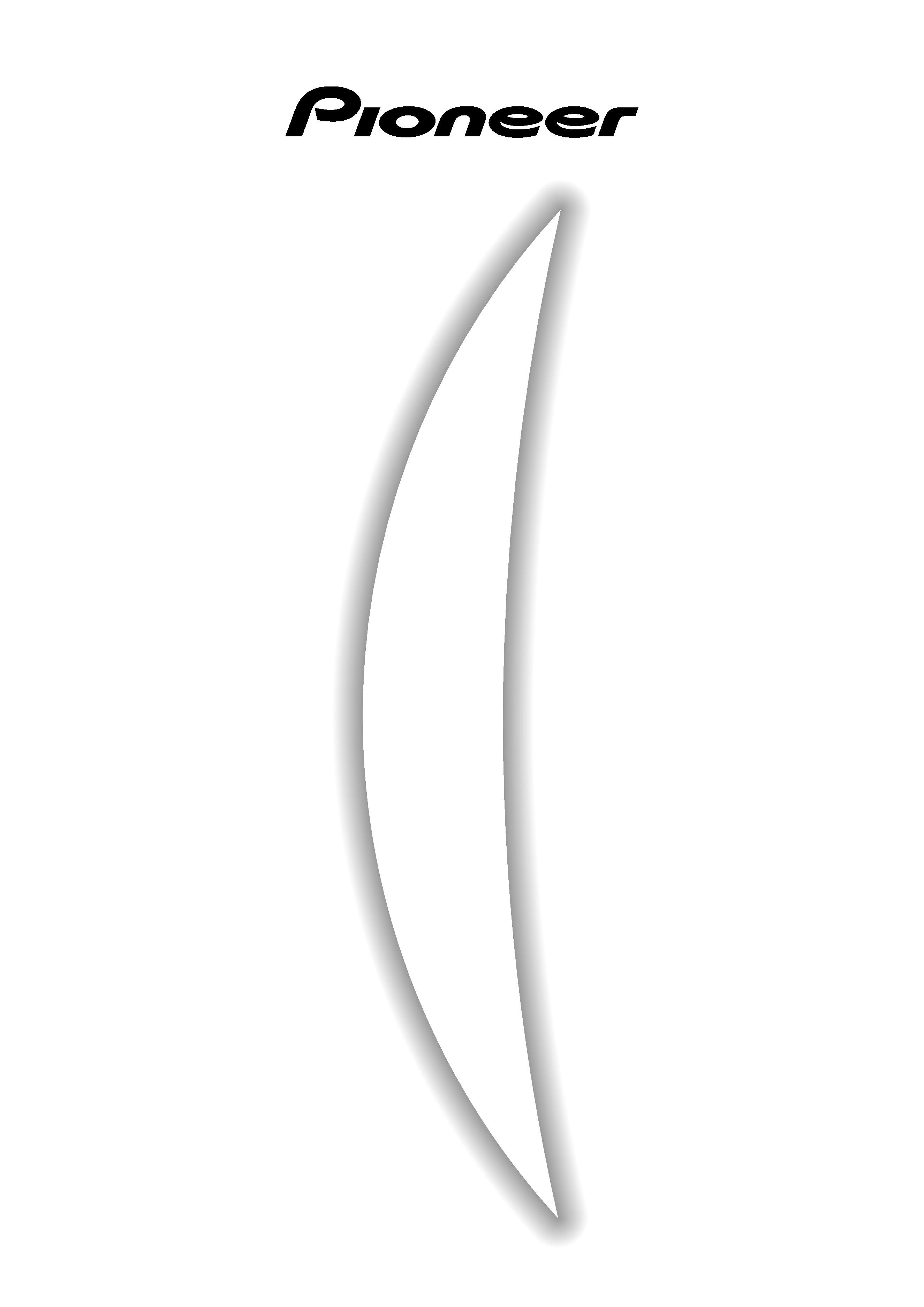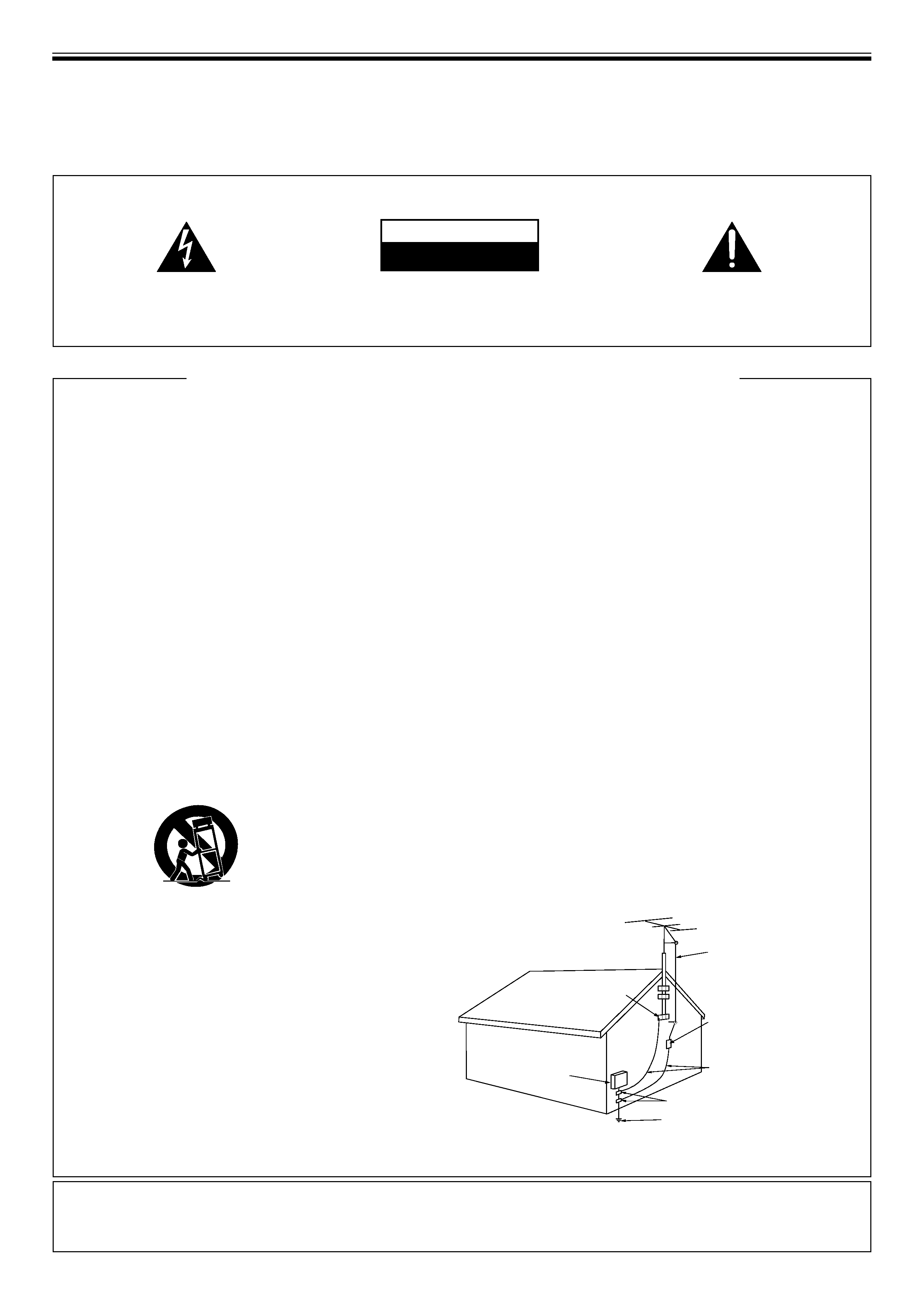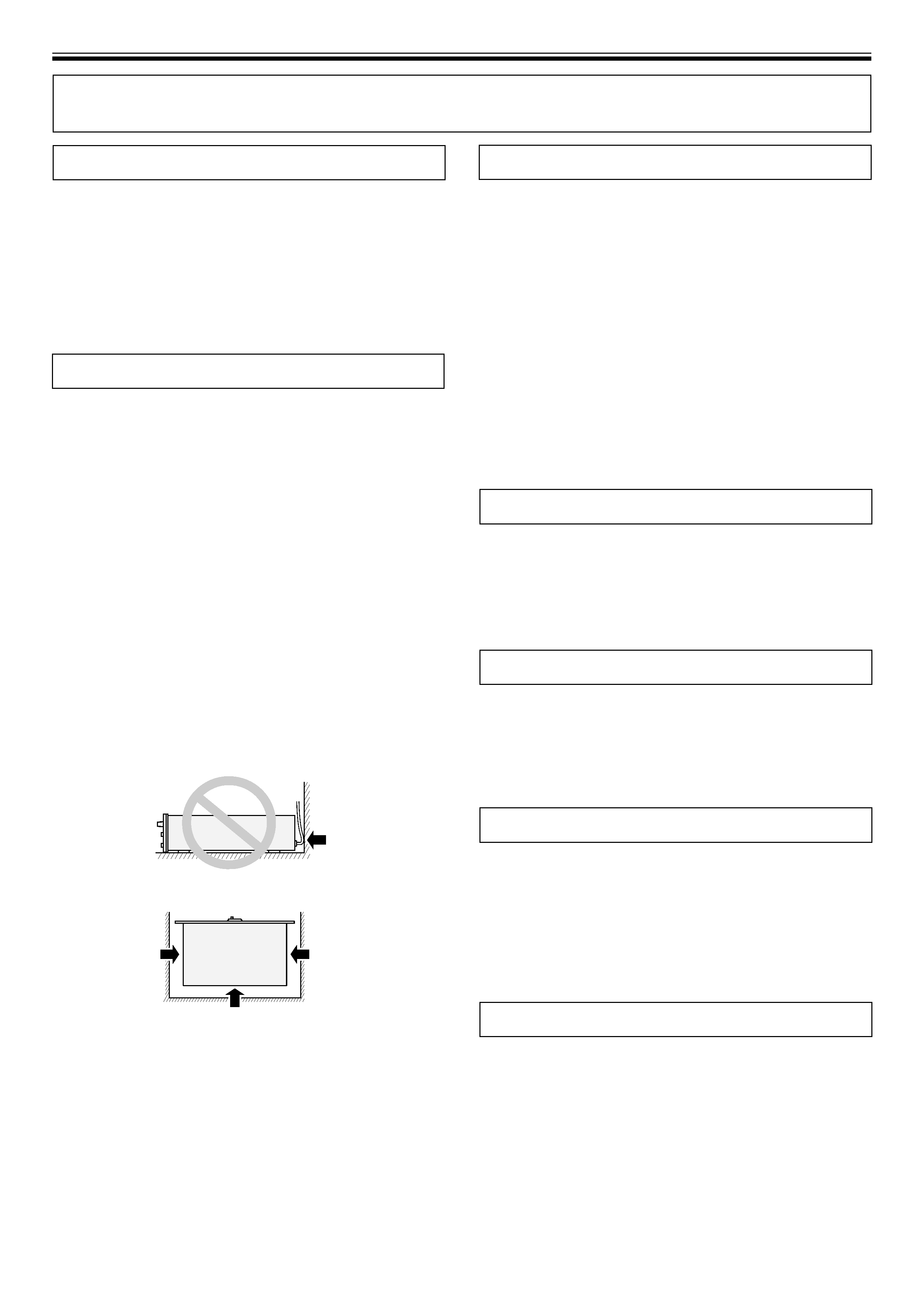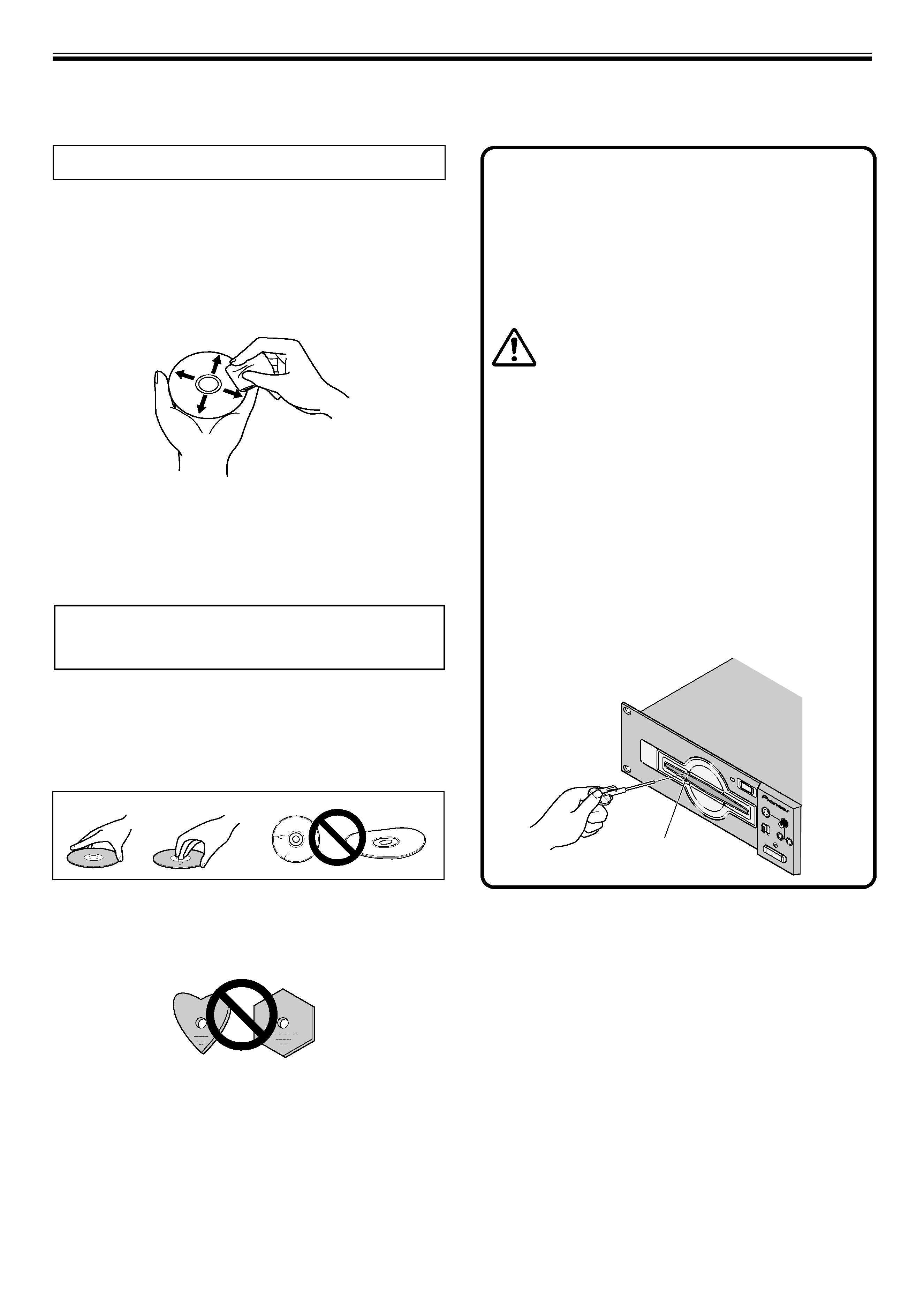
Operating Instructions
COMPACT DISC PLAYER
CMX-5000

2 <DRB1254>
READ INSTRUCTIONS -- All the safety and operating
instructions should be read before the product is
operated.
RETAIN INSTRUCTIONS -- The safety and operating
instructions should be retained for future reference.
HEED WARNINGS -- All warnings on the product and in
the operating instructions should be adhered to.
FOLLOW INSTRUCTIONS -- All operating and use
instructions should be followed.
CLEANING -- Unplug this product from the wall outlet
before cleaning. The product should be cleaned only
with a polishing cloth or a soft dry cloth. Never clean
with furniture wax, benzine, insecticides or other
volatile liquids since they may corrode the cabinet.
ATTACHMENTS -- Do not use attachments not
recommended by the product manufacturer as they
may cause hazards.
WATER AND MOISTURE -- Do not use this product near
water -- for example, near a bathtub, wash bowl,
kitchen sink, or laundry tub; in a wet basement; or
near a swimming pool; and the like.
ACCESSORIES -- Do not place this product on an
unstable cart, stand, tripod, bracket, or table. The
product may fall, causing serious injury to a child or
adult, and serious damage to the product. Use only
with a cart, stand, tripod, bracket, or table
recommended by the manufacturer, or sold with the
product. Any mounting of the product should follow
the manufacturer's instructions, and should use a
mounting accessory recommended by the
manufacturer.
CART -- A product and cart combination should be moved
with care. Quick stops, excessive force, and uneven
surfaces may cause the product and cart combination
to overturn.
VENTILATION -- Slots and openings in the cabinet are
provided for ventilation and to ensure reliable
operation of the product and to protect it from
overheating, and these openings must not be blocked
or covered. The openings should never be blocked
by placing the product on a bed, sofa, rug, or other
similar surface. This product should not be placed in
a built-in installation such as a bookcase or rack unless
proper ventilation is provided or the manufacturer's
instructions have been adhered to.
POWER SOURCES -- This product should be operated
only from the type of power source indicated on the
marking label. If you are not sure of the type of power
supply to your home, consult your product dealer or
local power company.
LOCATION -- The appliance should be installed in a stable
location.
NONUSE PERIODS -- The power cord of the appliance
should be unplugged from the outlet when left unused
for a long period of time.
WARNING: TO PREVENT FIRE OR SHOCK HAZARD, DO NOT EXPOSE THIS APPLIANCE TO RAIN OR MOISTURE.
IMPOTANT SAFETY INSTRUCTIONS
GROUNDING OR POLARIZATION
÷
If this product is equipped with a polarized alternating
current line plug (a plug having one blade wider than
the other), it will fit into the outlet only one way. This
is a safety feature. If you are unable to insert the plug
fully into the outlet, try reversing the plug. If the plug
should still fail to fit, contact your electrician to replace
your obsolete outlet. Do not defeat the safety purpose
of the polarized plug.
÷
If this product is equipped with a three-wire grounding
type plug, a plug having a third (grounding) pin, it will
only fit into a grounding type power outlet. This is a
safety feature. If you are unable to insert the plug
into the outlet, contact your electrician to replace your
obsolete outlet. Do not defeat the safety purpose of
the grounding type plug.
POWER-CORD PROTECTION -- Power-supply cords
should be routed so that they are not likely to be
walked on or pinched by items placed upon or against
them, paying particular attention to cords at plugs,
convenience receptacles, and the point where they
exit from the product.
OUTDOOR ANTENNA GROUNDING -- If an outside
antenna or cable system is connected to the product,
be sure the antenna or cable system is grounded so
as to provide some protection against voltage surges
and built-up static charges. Article 810 of the National
Electrical Code, ANSI/NFPA 70, provides information
with regard to proper grounding of the mast and
supporting structure, grounding of the lead-in wire to
an antenna discharge unit, size of grounding
conductors, location of antenna-discharge unit,
connection to grounding electrodes, and requirements
for the grounding electrode. See Figure A.
LIGHTNING -- For added protection for this product
during a lightning storm, or when it is left unattended
and unused for long periods of time, unplug it from
the wall outlet and disconnect the antenna or cable
system. This will prevent damage to the product due
to lightning and power-line surges.
POWER LINES -- An outside antenna system should not
be located in the vicinity of overhead power lines or
other electric light or power circuits, or where it can
fall into such power lines or circuits. When installing
an outside antenna system, extreme care should be
taken to keep from touching such power lines or
circuits as contact with them might be fatal.
OVERLOADING -- Do not overload wall outlets,
extension cords, or integral convenience receptacles
as this can result in a risk of fire or electric shock.
OBJECT AND LIQUID ENTRY -- Never push objects of
any kind into this product through openings as they
may touch dangerous voltage points or short-out parts
that could result in a fire or electric shock. Never spill
liquid of any kind on the product.
SERVICING -- Do not attempt to service this product
yourself as opening or removing covers may expose
you to dangerous voltage or other hazards. Refer all
servicing to qualified service personnel.
DAMAGE REQUIRING SERVICE -- Unplug this product
from the wall outlet and refer servicing to qualified
service personnel under the following conditions:
÷ When the power-supply cord or plug is damaged.
÷ If liquid has been spilled, or objects have fallen into
the product.
÷ If the product has been exposed to rain or water.
÷ If the product does not operate normally by following
the operating instructions. Adjust only those controls
that are covered by the operating instructions as an
improper adjustment of other controls may result in
damage and will often require extensive work by a
qualified technician to restore the product to its normal
operation.
÷ If the product has been dropped or damaged in any
way.
÷ When the product exhibits a distinct change in
performance -- this indicates a need for service.
REPLACEMENT PARTS -- When replacement parts are
required, be sure the service technician has used
replacement parts specified by the manufacturer or
have the same characteristics as the original part.
Unauthorized substitutions may result in fire, electric
shock, or other hazards.
SAFETY CHECK -- Upon completion of any service or
repairs to this product, ask the service technician to
perform safety checks to determine that the product
is in proper operating condition.
HEAT -- The product should be situated away from heat
sources such as radiators, heat registers, stoves, or
other products (including amplifiers) that produce heat.
NEC NATIONAL ELECTRICAL CODE
ANTENNA
LEAD IN WIRE
ANTENNA
DISCHARGE UNIT
(NEC SECTION 810 20)
GROUNDING CONDUCTORS
(NEC SECTION 810 21)
GROUND CLAMPS
POWER SERVICE GROUNDING
ELECTRODE SYSTEM
(NEC ART 250, PART H)
GROUND
CLAMP
ELECTRIC
SERVICE
EQUIPMENT
FIG. A
CAUTION
÷ Use of controls or adjustments or performance of procedures other than those specified herein may result in hazardous radiation
exposure.
÷ The use of optical instruments with this product will increase eye hazard.
IMPORTANT
The lightning flash with arrowhead symbol, within an
equilateral triangle, is intended to alert the user to the
presence of uninsulated "dangerous voltage" within the
product's enclosure that may be of sufficient magnitude
to constitute a risk of electric shock to persons.
The exclamation point within an equilateral triangle is
intended to alert the user to the presence of important
operating and maintenance (servicing) instructions in
the literature accompanying the appliance.
CAUTION:
TO PREVENT THE RISK OF ELECTRIC SHOCK, DO
NOT REMOVE COVER (OR BACK).
NO USER-
SERVICEABLE PARTS INSIDE. REFER SERVICING TO
QUALIFIED SERVICE PERSONNEL.
CAUTION
RISK OF ELECTRIC SHOCK
DO NOT OPEN
Thank you for buying this Pioneer product.
Please read through these operating instructions so you will know how to operate your model properly.
After you have finished reading the instructions, put them away in a safe place for future reference.
Read before use

<DRB1254>
3
We
Want You
LISTENING
For A Lifetime
·A
S
S O C I A TIO
N
·
E
L
E
C
T
R
O
NI
C IND
U
S
T
R
IE
S
EST
1924
We
Want You
LISTENING
For A Lifetime
·A
S
S O C I A TIO
N
·
E
L
E
C
T
R
O
NI
C IND
U
S
T
R
IE
S
EST
1924
[For Canadian model]
This Class B digital apparatus complies with Canadian
ICES-003.
[Pour le modèle Canadien]
Cet appareil numérique de la Classe B est conforme à la
norme NMB-003 du Canada.
Information to User
Alteration or modifications carried out without
appropriate authorization may invalidate the user's right
to operate the equipment.
This equipment has been tested and found to comply with the limits for a Class B digital device, pursuant to Part 15 of the
FCC Rules. These limits are designed to provide reasonable protection against harmful interference in a residential
installation. This equipment generates, uses, and can radiate radio frequency energy and, if not installed and used in
accordance with the instructions, may cause harmful interference to radio communications. However, there is no
guarantee that interference will not occur in a particular installation. If this equipment does cause harmful interference
to radio or television reception, which can be determined by turning the equipment off and on, the user is encouraged to
try to correct the interference by one or more of the following measures:
Reorient or relocate the receiving antenna.
Increase the separation between the equipment and receiver.
Connect the equipment into an outlet on a circuit different from that to which the receiver is connected.
Consult the dealer or an experienced radio/TV technician for help.
Selecting fine audio equipment such as the unit you've just
purchased is only the start of your musical enjoyment. Now it's time
to consider how you can maximize the fun and excitement your
equipment offers. This manufacturer and the Electronic Industries
Association's Consumer Electronics Group want you to get the most
out of your equipment by playing it at a safe level. One that lets the
sound come through loud and clear without annoying blaring or
distortion-and, most importantly, without affecting your sensitive
hearing.
Sound can be deceiving. Over time your hearing "comfort level"
adapts to higher volumes of sound. So what sounds "normal" can
actually be loud and harmful to your hearing. Guard against this by
setting your equipment at a safe level BEFORE your hearing adapts.
To establish a safe level:
÷ Start your volume control at a low setting.
÷ Slowly increase the sound until you can hear it comfortably and
clearly, and without distortion.
Once you have established a comfortable sound level:
÷ Set the dial and leave it there.
Taking a minute to do this now will help to prevent hearing damage
or loss in the future. After all, we want you listening for a lifetime.
We Want You Listening For A Lifetime
Used wisely, your new sound equipment will provide a lifetime of
fun and enjoyment. Since hearing damage from loud noise is often
undetectable until it is too late, this manufacturer and the Electronic
Industries Association's Consumer Electronics Group recommend
you avoid prolonged exposure to excessive noise. This list of sound
levels is included for your protection.
30
Quiet library, soft whispers
40
Living room, refrigerator, bedroom away from traffic
50
Light traffic, normal conversation, quiet office
60
Air conditioner at 20 feet, sewing machine
70
Vacuum cleaner, hair dryer, noisy restaurant
80
Average city traffic, garbage disposals, alarm clock
at two feet.
Decibel
Level
Example
THE FOLLOWING NOISES CAN BE DANGEROUS
UNDER CONSTANT EXPOSURE
90
Subway, motorcycle, truck traffic, lawn mower
100
Garbage truck, chain saw, pneumatic drill
120
Rock band concert in front of speakers, thunderclap
140
Gunshot blast, jet plane
180
Rocket launching pad
Information courtesy of the Deafness Research Foundation.
CAUTION: This product satisfies FCC regulations when
shielded cables and connectors are used to connect the unit to
other equipment. To prevent electromagnetic interference with
electric appliances such as radios and televisions, use shielded
cables and connectors for connections.
IMPORTANT NOTICE
The serial number for this equipment is located on the rear
panel. Please write this serial number on your enclosed warranty
card and keep it in a secure area. This is for your security.
[For Canadian model]
CAUTION: TO PREVENT ELECTRIC SHOCK DO NOT USE
THIS (POLARIZED) PLUG WITH AN EXTENSION CORD.
RECEPTACLE OR OTHER OUTLET UNLESS THE BLADES CAN
BE FULLY INSERTED TO PREVENT BLADE EXPOSURE.
ATTENTION: POUR PREVENIR LES CHOCS ELECTRIQUES
NE PAS UTILISER CETTE FICHE POLARISEE AVEC UN
PROLONGATEUR UNE PRISE DE COURANT OU UNE AUTRE
SORTIE DE COURANT, SAUF SI LES LAMES PEUVENT ETRE
INSEREES A FOND SANS EN LAISSER AUCUNE PARTIE A
DECOUVERT.
Read before use

4 <DRB1254>
CAUTIONS REGARDING HANDLING
Location
Install the player in a well-ventilated location where it will not be
exposed to high temperatures or humidity.
Do not install the player in a location which is exposed to direct
sunlight, or near stoves or radiators. Excessive heat can
adversely affect the cabinet and internal components.
Installation of the player in a damp or dusty environment may
aiso result in a malfunction and can be hazardous. Avoid
installation near cookers etc., where the player may be exposed
to oily smoke, steam or heat.
Installation guidelines
÷ Placing and using the compact disc player for long periods on
heat-generating sources such as amplifiers or near
spotlights, etc. will affect product performance. Avoid placing
the player on heat-generating sources.
÷ Install this compact disc player as far as possible away from
tuners and TV sets. A compact disc player installed in close
proximity to such equipment may cause noise or degradation
of the picture.
÷ Noise may be noticeable when an indoor antenna is used. In
such cases, make use of an outdoor antenna or turn off
power to the compact disc player.
÷ When the unit is used in a loud-sound environment, e.g., near
a speaker, sound skip may occur. Install the unit away from
the speaker or reduce the listening volume.
÷ Place this unit on a level surface and a stable platform.
÷ Be sure the player, including its audio and power supply
cords, does not touch vibrating materials. Any cause of
vibration other than the insulators may cause the disc to skip.
Take special care when using the player while it is installed in
a carrying case.
Installing the CMX-5000 in an EIA rack
The screw holes on the front panel o the CMX-5000 are
designed for use in attaching the unit to a 19-inch EIA rack.
÷ Remove the four legs on the unit before installing the unit in
the rack.
÷ Use four 3/16-inch-diameter, 3/8-inch-length screws to attach
to rack. (Screws not included with CMX-5000 CD player.)
Note
÷ Never place this CD player directly above a power amplifier,
as the heat given off by the amplifier might result in damage
to the unit. Placing the CD player directly above a power
amplifier might also result in ham radio signals being picked
up or in other types of interference.
÷ Always be sure to remove the CD player from its rack before
shipping.
÷ When moving the CD player while still installed in its rack,
exercise caution to avoid subjecting the player to shocks or
vibration.
Cleaning the player
To clean the PLAYER wipe with a polishing or a soft, dry cloth.
For stubborn dirt, moisten a soft cloth with a weak solution of
neutral detergent (diluted in five to six parts water), wring the
cloth well, and wipe away the dirt. Use a dry cloth to wipe the
surface dry. Do not use volatile liquids such as benzene or
thinner which will damage to the unit.
CD lens cleaner
The player's pickup lens should not become dirty in normal use.
If for some reason, the lens becomes soiled and malfunctions,
contact your nearest PIONEER authorized service center. Lens
cleaners for CD players are commercially available, but special
care should be exercised in their use as some may cause
damage to the lens.
Storing discs
÷ Discs are made of the same kinds of plastic used for
conventional analog audio records. Be careful not to allow
discs to warp. Always store discs in their cases vertically,
avoiding locations with high heat, humidity, or extremely low
temperatures. Avoid leaving discs in cars; the interior of a car
in direct sunlight can become extremely hot.
÷ Always read and abide by the precautionary notes listed on
disc labels.
Condensation
When this unit is brought into a warm room from previously cold
surroundings or when the room temperature rises sharply,
condensation may form inside the unit and impair its
performance. In such cases, allow the unit to stand for about an
hour or raise the room temperature gradually.
Read before use
Do not place on or against
vibrating materials!

<DRB1254>
5
'
Do not play a CD with a special shape
Do not play a CD having other shape than a circular disc, such as
heart shaped disc. Otherwise malfunction may occur.
FORCED DISC EJECTION
If the EJECT button fails to work and it becomes impossible
to eject a disc, the disc may be ejected by inserting the disc
ejection pin in the manual disc ejection hole located on the
front panel of the player.
Always be sure to observe the following points when
manually ejecting discs.
1 Be sure to turn off the power to the CD player and wait
for 1 minute or more before ejecting the disc.
Manually ejecting a disc immediately after the
power to the unit has been turned off may
result in one of the following problems from
occurring, and care should accordingly be
taken never to eject discs immediately after the
power has been turned off.
÷ The disc will still be spinning when it is ejected, thus
resulting in cuts to the fingers or other forms of bodily
injury.
÷ The disc clamps will spin in an unstable state, thus
resulting in scratching of discs.
2 Be sure to use only the disc ejection pin included with
your CMX-5000 (i.e., never use a paper clip or any other
object).
Inserting the disc ejection pin into the hole until it
encounters resistance will cause the disc to be ejected
some 5 to 10 millimeters from the insertion slot. The
disc may then be removed by grasping it by hand and
pulling.
Read before use
EJE
CT
DIS
C
A
PLA
YE
R
'
0
A·B
AU
DIO
-OU
T S
ELE
CT
MONITOR
MIN
MAX
PHONES
A·B
A·B
/
AU
TO
MIX PLA
YER
SELECT
AB
PO
W
ER
Manual
disc ejection hole
÷ If a disc becomes very dirty, dampen a soft cloth with water,
(be sure to wring it out well) and wipe the away dirt gently.
Remove any water drops with another soft, dry cloth.
÷ Do not use record cleaning sprays or anti-static agents on
discs. Never clean discs with benzene, thinner, or other
volatile solvents or damage to the disc surface may result.
÷ With this player, use only those discs
which display the mark shown right
(Optical audio digital discs).
÷ When holding discs, do not touch their signal surfaces. Hold
by the edges, or by one edge and the center hole.
÷ Do not affix gummed labels or tape to the disc surface. Also,
do not scratch or damage the label.
÷ Discs rotate at high speeds inside the player. Do not use
damaged, cracked or warped discs.
Cleaning and handling compact discs
÷ The presence of fingerprints or smudges on the surface of
the disc will not directly affect the recorded signals, but,
depending on the degree of contamination, the brightness of
the light reflected from the signal surfaces may be reduced
causing degradation of sound quality. Always keep your discs
clean by wiping them gently with a soft cloth from the inner
edge toward the outer edge.
